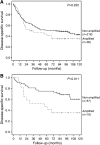Association of ERBB2 gene status with histopathological parameters and disease-specific survival in gastric carcinoma patients
- PMID: 19156142
- PMCID: PMC2658544
- DOI: 10.1038/sj.bjc.6604885
Association of ERBB2 gene status with histopathological parameters and disease-specific survival in gastric carcinoma patients
Abstract
The clinical significance of ERBB2 amplification/overexpression in gastric cancer remains unclear. In this study, we evaluated the ERBB2 status in 463 gastric carcinomas using immunohistochemistry (IHC) and fluorescence in situ hybridisation (FISH), and compared the findings with histopathological characteristics and with disease-specific survival. ERBB2 overexpression (2+ and 3+) and amplification (ratio ERBB2/CEP17 >or= 2) were found in 43 (9.3%) and 38 (8.2%) gastric carcinomas, respectively. Perfect IHC/FISH correlation was found for the 19 cases scored as 0 (all negative by FISH), and also for the 25 cases scored as 3+ (all positive by FISH). One out of six carcinomas scored as 1+ and 12 out of 18 carcinomas scored as 2+ were positive by FISH. ERBB2 amplification was associated with gastric carcinomas of intestinal type (P=0.007) and with an expansive growth pattern (P=0.021). ERBB2 amplification was detected in both histological components of two mixed carcinomas, indicating a common clonal origin. A statistically significant association was found between ERBB2 amplification and worse survival in patients with expansive gastric carcinomas (P=0.011). We conclude that ERBB2 status may have clinical significance in subsets of gastric cancer patients, and that further studies are warranted to evaluate whether patients whose gastric carcinomas present ERBB2 amplification/overexpression may benefit from therapy targeting this surface receptor.
Figures



References
-
- Akiyama T, Sudo C, Ogawara H, Toyoshima K, Yamamoto T (1986) The product of the human c-erbB-2 gene: a 185-kilodalton glycoprotein with tyrosine kinase activity. Science 232: 1644–1646 - PubMed
-
- Becker KF, Atkinson MJ, Reich U, Becker I, Nekarda H, Siewert JR, Hofler H (1994) E-cadherin gene mutations provide clues to diffuse type gastric carcinomas. Cancer Res 54: 3845–3852 - PubMed
-
- Carneiro F (1997) Classification of gastric carcinomas. Curr Diag Pathol 4: 51–59
-
- Cimerman M, Repse S, Jelenc F, Omejc M, Bitenc M, Lamovec J (1994) Comparison of Lauren's, Ming's and WHO histological classifications of gastric cancer as a prognostic factor for operated patients. Int Surg 79: 27–32 - PubMed
Publication types
MeSH terms
LinkOut - more resources
Full Text Sources
Medical
Research Materials
Miscellaneous

